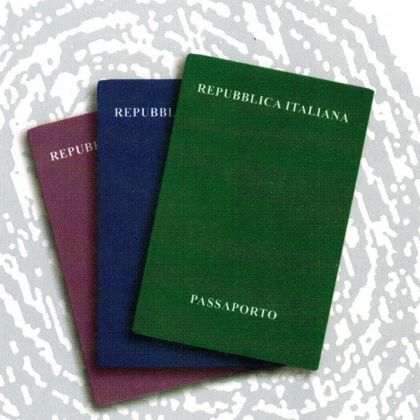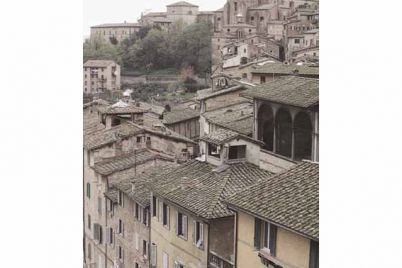The title of this article, besides recalling a popular Renato Carosone tune from the 1950s, implies, with the verb fare, an active making of or participation in the process of selfhood. In my own case, a son of Abruzzese immigrants born in Venezuela, raised in the United States, currently living in Canada, I am officially listed in the city hall records of Sulmona, Italy, as a figlio d’italiano nato all’estero. This apparently affords me all the privileges of Italian citizenship without the disrupting obligation of military service.
Recently, however, the Italian Parliament has changed the official appellation of its wayward sons and daughters no longer referred to as immigranti – considered a dated, sometimes derogatory appellation – but now officially as italiani nel mondo.
So here I am, no longer defined by the charged term immigrante with all its politically incorrect connotations. I stand before you as an Italian, rather, un italiano nel mondo. This is no small feat. In a heartbeat I have gone from a wannabe to an ipso facto. Indeed, I am now an Italian in propria persona. Beyond my political status, however, existential queries remain: What, indeed, is an italiano nel mondo? What images have I appropriated or dispelled from the conventional repertoire of accepted peninsular and North American Italian tropes that allow me to consider myself a part of Italian culture on a world stage? Further, as an Italian-American (I grew up in the United States), what presumption permits me to claim a heritage that, in many respects, is as detached from my Italian-American immigrant experience as it is from oriental culture?
I have to admit that as a youth I was often puzzled as to why, whenever I say what I thought was the mathematical equation Italian – (read minus) American, I never knew the answer. What did Italian minus American equal? Why was there never a solution to this simple arithmetic problem of subtraction? Conversely, what would American (North America) minus Italian (Italians) equal? What if Italians had not, with their toil and dreams, helped build North America? What if there had been no America for Italians to discover? I’ve never really laid these questions to rest.
Mythopoeia or myth making is an ongoing process. The distilled narratives of the past link up with the plausible accounts of the present to produce the archetypes and stereotypes that will enlighten or shadow our collective futures. The sorting, the classification, the application of this information is the product of socialization experiences that form us, of the prejudices that nurture us, of the dreams that sustain us.
The immigrant mythology is one that crosses international boundaries. Fish out of water, men without homes, the legacy of the immigrant is that of cultural refugee. Like many of our parents, my father holds a deep-set antipathy for the country that so callously ejected him from her fold. He is a cultural martyr. Am I thus the heir of despair or of hope? Do I romanticize my father’s plight or disregard a stereotypical legacy? Where does my so-called italianitàso important since it is traditionally viewed as determinant in this argument) begin and “mangiacake” Americanism end?
The answer is crucial because these mythologies are our empowering testimonies, the lifeblood and essence of who and what we are. As images of who we are, these mythologies become the text of what we wish to be. Safe and secure modelling by our elders, a reasonable narrative plot ideated by our parents, a plausible script mapped by ourselves creates a knowable world out of the chaos that envelops us daily. This is even more true for the immigrant, where images of self are played out in the often hostile and destabilizing social and cultural contexts of an adoptive country often alien to the most benign models of acculturation.
If there is a crisis of Italian Canadian identity, some of it is due to issues of misrepresentation, to the noise that is muddying the system. Much of this noise reverberates from the new political will that Italy has found and that wishes to re-educate, re-absorb, indeed re-exploit its once neglected immigrants as convenient economic ambassadors. Take, for example, the computerized images of recuperated identity that RAI International transmits 24 hours daily around the globe. The engaging images promote the notion of Italy as a culture of beautiful vistas, of romantic semblances, of fashionable simulacra.
Making oneself into an Italian, fare l’italiano, regardless of where one was born, has never been easier. It is now almost totally dependent upon the visual culture that spews from satellites orbiting in space. The new archeology of RAI International Italianicity may occasionally include life history accounts of immigrants that have made it big in the new world. However, the travails of everyday existence, the values of immigrant political, cultural, and social models, remain a hidden, even inconvenient, commonplace to be avoided. Too common, it seems, to recount. The result is that local immigrant images struggle for recognition within a canonized TV network because they do not fit the new image of being Italian.
Furthermore, the verbal text, the authentic voice of the immigrant as a “speaking subject” of the language that incorporated the original culture has given way to an “Other” that merely needs to be seen to possess the requisite accoutrements (the clothes, the cars, the style) in order to be considered Italian. Language, in other words, is not paradigmatic for meaning. The new grammar of the immigrant has been decentred from phonocentric to photocentric, from saying to seeing. Subsequently, this visual culture requires a visual literacy that only figli d’italiani nati all’estero can effectively translate, if only because the purely logocentric world of their parents has truly been supplanted by a visual culture in which they eagerly participate but barely understand.
The new image or world view of the new italiano nel mondo, then, is born from a systemic shift that does not correspond to actual lived experience (the verbal text of the father; the daily experiences of the subject, the repertoire of shared immigrant memories), but is grounded instead in European accounts of convenient visual experiences and in systematic projections of an alien (Italian) reality. So exactly which image, amongst all the possible and alluring descriptions we are presented, are we to imitate?
The engagingly dense image that RAI International projects poses questions about dominant models, cultural imaging, historical reification, and global electronic visual culture.
The problem with RAI International’s discourse is that it is all absorbing, since it presents only current peninsular mores, attitudes, issues, styles. When it does show the immigrant experience, RAI prefers to highlight businessmen who have made it big, many of whom, however, are recent emigrees – Italians, in other words, and not mom and pop store owners who struggled to send their children to college. Rather than being an informative narrative, then, immigrant discourse is absorbed into RAI’s political vortex and is used to prop-up a peninsular paradigm: italiani nel mondo are successful, industrious, wealthy.
Questions of difference and distinctness – of Italo hyphen American, Canadian, Argentinian, Chilean, Australian, Belgian – fall into the melting pot of RAI International’s Italian minestrone. Instead of creating a dialogue between the immigrant communities and the mother country, the supposed dynamic examinations of immigrant realities are entrenched in sameness and repetition, and amount to a retelling of tired conventions. The spectator, in other words, only sees what he is fed, and only learns what is portrayed as laundered and rewritten immigrant history. This image, in many ways, severs the immigrant from his own reality.
Ultimately, then, RAI International is about itself. It may be the pallette upon which immigrants project their latent desires (to return to Italy, to view what was left behind, to re-capture the lost self that was never allowed to fully develop into the image displayed on the TV screen), but it does not present a true or even alternate reading of immigrants.
The immigrant is not an historical subtext to be exploited by RAI International, nor is he a subculture of a dominant Italian-Other-culture. He is instead a fundamental potentiality, a non-negotiable sign of alterity. He is the nexus where cultures intersect, where languages forge new texts, and where the social antagonisms of difference, representation and similitude play themselves out in a constantly shifting social dialectic. In this vital game of survival, the most damaging condition of the immigrant is the reiteration of dominant Italian peninsular paradigms. Indeed the death knell of my argument would be to resume the comparative strategy of examining the prevailing tropes of differentiation between the representative cultures. The real question to ask is: Why ask these questions about difference at all? Why focus on displacement? The starting point of any discussion of the immigrant must be the rights of the individual seen as a complex, mixed, and heterogeneous re-presentation of a new and novel discourse.
In the end, the immigrant is perhaps at best just a noble social experiment, a type of cultural economic psychological being who lives at the limen of acceptance and repulsion, textual and visual perception, the ultimate tautology, a model of itself for itself. This model avoids the ambiguous designations foisted upon us by others and indeed by ourselves. The search for a proper equivalent in the Italian master code, for psychological closure may be a normal aspiration of the displaced immigrant. But it should not be our goal. To deny our incompatibility with the master code is a dead end to be avoided for it forebodes collective suicide. To become un italiano nel mondo is to pass surreptitiously from a place where one acts to one where one is merely a spectator. Our binary relation must remain open in order to preserve the dignity of our past.
To be an immigrant is a transgressive act, an affirmation of cultural singularity. Why must we fare l’italiano, when we haven’t yet learned to be immigrants?
Franco Ricci is professor of Italian Studies at the University of Ottawa.
First published in Accenti Magazine, Issue 4.



